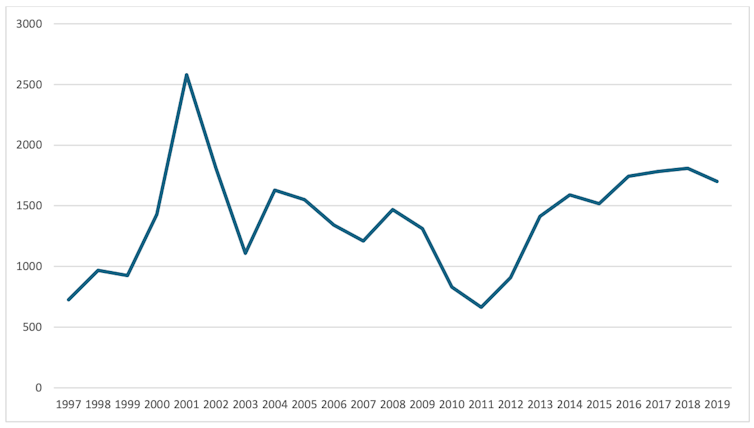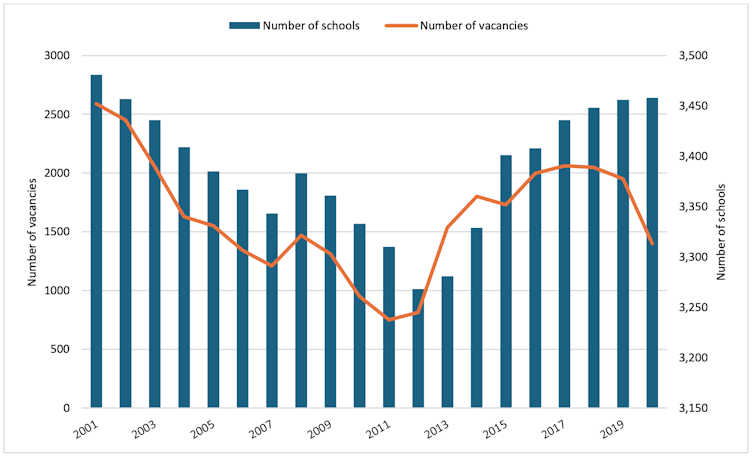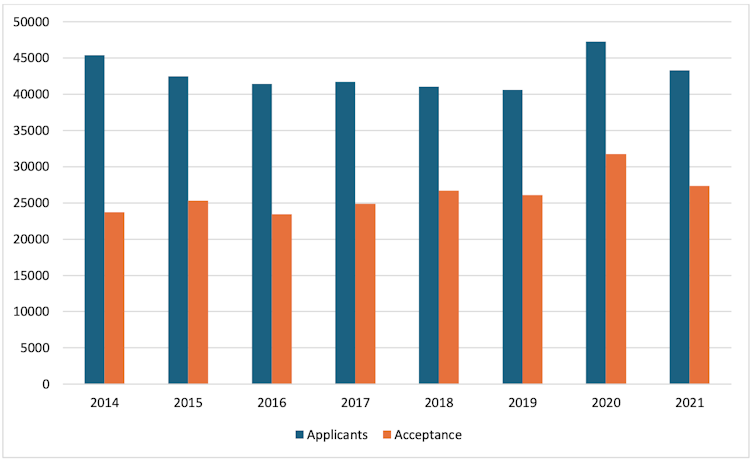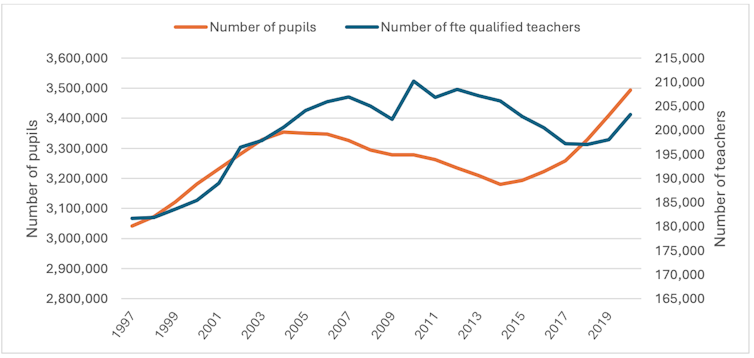Why UK government policies have failed to recruit enough teachers for years

England has faced years of teacher shortages, especially in some secondary subjects such as maths, science and technology. Successive governments have tried – and failed – to address these shortages.
The Return to Teaching programme, introduced in 2015, was intended to tempt ex-teachers back into service to teach certain subjects at secondary school. The Department for Education spent nearly £600,000 recruiting 27 teachers who met this aim.
This was followed by the National Teaching Service, intended to place 1,500 teachers in underperforming schools in areas struggling to recruit teachers. The pilot scheme, implemented in September 2016, was scrapped having recruited only 24 teachers. The 2018 Troops to Teachers scheme, which offered ex-service personnel £40,000 to train as teachers, recruited just 22 people in its first year.
Other direct measures to attract people into teaching have included providing new routes into teaching, such as school-led and employment-based training. The government currently offers upfront payments for new teachers in the form of bursaries and scholarships, as well as student loan reimbursement. In 2023-24, £196m is expected to be spent on payments for prospective and new teachers.
Yet these approaches have had little or no success. Unfortunately, one-off payments do not work. In 2023-24, the government offered training scholarships and bursaries worth up to £29,000 to attract physics teachers, but only managed to recruit 17% of the target number of teachers.
A lot of time and effort has been wasted. My research with colleagues over 20 years suggests why.
Why don’t these initiatives work?
The direct approach to recruitment, such as offering payments or new ways to enter the profession, often fails. It is hindered by the fact that teacher shortages – the gap between the number of teachers needed and the number available – are affected by so many varied factors.
One of these is the number of schools. When Tony Blair’s New Labour government came into power in 1997, huge investments were made in education. Spending per pupil grew rapidly from 1999 onwards, with the biggest increase between 2000 and 2001.
Schools wanted to use the money to hire more staff, so the apparent demand for teachers grew. This period saw a sudden increase in advertised teacher vacancies – which is often misinterpreted as illustrating a shortage of teachers.
Teacher vacancies over time in England:

After 2001, many small schools were forced to close or merge due to falling numbers – a consequence of declining birth rates and movement of families out of certain areas for reasons such as rising housing costs or to be near popular schools. This led to a trend for fewer, bigger schools for some years – and demand for teachers, and so vacancies, fell. We are seeing similar patterns in primary schools in London now.
Under the coalition government from 2010, there was an increase in the number and types of schools. This period saw the introduction of free schools, studio schools, university technological colleges, and an increasing number of academies. This has led to more small schools which need a full staff despite small class sizes – and so demand for teachers has increased once again.
Number of schools compared to teacher vacancies:

Other policies have also increased the demand for teachers. From 2015 onwards, the Conservative government under David Cameron brought in a number of education reforms. These included extending the education and training age from 16 to 18, meaning that young people stay in education for longer and so more teachers are needed to teach them.
The Conservative government also introduced the English Baccalaureate in 2010. The EBacc is a performance measure for schools which requires secondary pupils to take English, maths, the sciences, one humanities subject (history or geography) and a language at GCSE. This means more teachers are needed for these subjects. Only 55% of the target number of teachers in EBacc subjects were recruited in 2023-24.
None of these policies have so far been implemented in synchronisation with explicit plans for more teachers. Other factors not directly related to education can also affect teacher supply, such as graduate employment rates, inflation and the cost of living.
The current government introduced the Teacher Recruitment and Retention Strategy in 2019, which prioritises workload reduction, but there is no sign yet that this has worked.
Yet there is no actual shortage of people wanting to be teachers. There are more people applying to be teachers than there are places available.
Numbers of applicants and places offered:

The rate of acceptance onto teacher training courses over the years has been under 70%, suggesting that 30% of applicants have been rejected. Many of those turned away from some training institutions are better qualified than those accepted at others. There is also a serious problem of low acceptance of ethnic minority applicants.
In general, teacher numbers keep pace with pupil numbers but lag behind them by a few years, as it takes time to recruit and train the number of teachers required by any changes in policy.
Changes in teacher and pupil numbers:

What’s more, government reforms to initial teacher training appear to have actually suppressed the number of people who can be trained. For example, between 2013-14 and 2015-16, the then-education secretary, Michael Gove, increased the number of training places in schools via the School Direct route, a school-based teacher training programme. At the same time, the number of training places in universities was capped, at a time when the demand for teachers was particularly high.
In short, planning for teacher supply is hamstrung because of how closely it is linked to politics.
This article is republished from The Conversation under a Creative Commons license. Read the original article.

Beng Huat See receives funding from the Economic and Social Research Council

 Yahoo News
Yahoo News 
